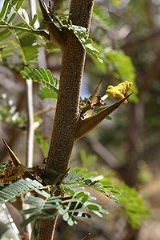
Acacia collinsii
Encyclopedia
Acacia collinsii is a species
of flowering plant
. It grows in secondary succession in seasonally dry ecosystems in southern Central America
, where it exhibits a symbiotic relationship with several species of ant
(Pseudomyrmex spinicola
, Pseudomyrmex ferruginea
). The ant-Acacia system involving this species has been studied by ecologists like Daniel Janzen
in Palo Verde National Park
and Santa Rosa National Park
, both in Guanacaste Province
, Costa Rica
. The ants chew holes in the tips of the hollow stipular thorns, known as domatia
, so that they can enter, and create their colony inside. A single ant colony may span several A. collinsii trees.
The ants protect the trees from attack by other insects. Some ant species even cut down vegetation on the ground surrounding their trees and trim the encroaching branches of other plants, which allows the A. collinsii trees to thrive. In exchange, A. collinsii not only provides the ants with hollow thorns in which to live, but also produces lipid- and protein-rich food bodies, known as Beltian bodies, on the tips of new leaflets, which are consumed by the ants and are critical for larval growth. Acacia collinsii also provides the ants with sugar-rich nectar from extrafloral nectaries located at the leaf petiole
.

Species
In biology, a species is one of the basic units of biological classification and a taxonomic rank. A species is often defined as a group of organisms capable of interbreeding and producing fertile offspring. While in many cases this definition is adequate, more precise or differing measures are...
of flowering plant
Flowering plant
The flowering plants , also known as Angiospermae or Magnoliophyta, are the most diverse group of land plants. Angiosperms are seed-producing plants like the gymnosperms and can be distinguished from the gymnosperms by a series of synapomorphies...
. It grows in secondary succession in seasonally dry ecosystems in southern Central America
Central America
Central America is the central geographic region of the Americas. It is the southernmost, isthmian portion of the North American continent, which connects with South America on the southeast. When considered part of the unified continental model, it is considered a subcontinent...
, where it exhibits a symbiotic relationship with several species of ant
Ant
Ants are social insects of the family Formicidae and, along with the related wasps and bees, belong to the order Hymenoptera. Ants evolved from wasp-like ancestors in the mid-Cretaceous period between 110 and 130 million years ago and diversified after the rise of flowering plants. More than...
(Pseudomyrmex spinicola
Pseudomyrmex spinicola
Pseudomyrmex spinicola is a species of red myrmecophyte-inhabiting neotropical ants which are found only in Nicaragua and Costa Rica. They live in the thorns of a tropical tree, Acacia collinsii, feeding on nectaries along with the protein and lipid-rich beltian bodies...
, Pseudomyrmex ferruginea
Pseudomyrmex ferruginea
The acacia ant is a species of ant of the genus Pseudomyrmex. These arboreal, wasp-like ants have a orange-brown body around 3 cm in length and very large eyes...
). The ant-Acacia system involving this species has been studied by ecologists like Daniel Janzen
Daniel Janzen
Daniel Hunt Janzen is an evolutionary ecologist, naturalist, and conservationist and the son of a previous Director of the US Fish and Wildlife Service...
in Palo Verde National Park
Palo Verde National Park
The Palo Verde National Park, in Spanish is a National Park of Costa Rica, part of the Tempisque Conservation Area, that contains much of the area of the valley of the Tempisque River and covers an area of 45,492 acres in Guanacaste Province, 30 km west of Canas...
and Santa Rosa National Park
Santa Rosa National Park
Santa Rosa National Park, in Spanish the , is a national park, part of the Area de Conservación Guanacaste World Heritage site, in the northern western part of Costa Rica, originally created to protect the scene of the Battle of Santa Rosa, at its eastern edge lies the Interamerican Highway where...
, both in Guanacaste Province
Guanacaste Province
Guanacaste is a province of Costa Rica located in the northwestern part of the country, along the coast of the Pacific Ocean. To the north it borders Nicaragua. To the east is the Alajuela Province, and to the southeast is the Puntarenas Province. It is the most sparsely populated of all the...
, Costa Rica
Costa Rica
Costa Rica , officially the Republic of Costa Rica is a multilingual, multiethnic and multicultural country in Central America, bordered by Nicaragua to the north, Panama to the southeast, the Pacific Ocean to the west and the Caribbean Sea to the east....
. The ants chew holes in the tips of the hollow stipular thorns, known as domatia
Domatia
Domatia are tiny chambers produced by plants that house arthropods.Domatia differ from galls in that they are produced by the plant rather than being induced by their inhabitants...
, so that they can enter, and create their colony inside. A single ant colony may span several A. collinsii trees.
The ants protect the trees from attack by other insects. Some ant species even cut down vegetation on the ground surrounding their trees and trim the encroaching branches of other plants, which allows the A. collinsii trees to thrive. In exchange, A. collinsii not only provides the ants with hollow thorns in which to live, but also produces lipid- and protein-rich food bodies, known as Beltian bodies, on the tips of new leaflets, which are consumed by the ants and are critical for larval growth. Acacia collinsii also provides the ants with sugar-rich nectar from extrafloral nectaries located at the leaf petiole
Petiole
Petiole may refer to:*Petiole , the stalk of a leaf, attaching the blade to the stem*Petiole , the stem formed by a restricted abdominal segment that connects the thorax with the gaster in the suborder Apocrita...
.


